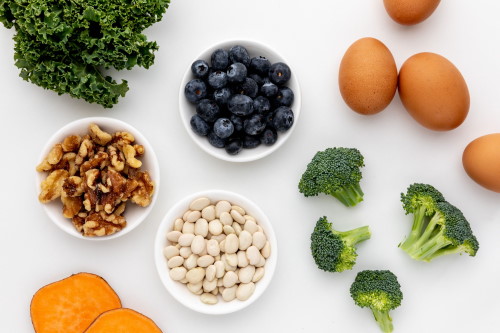Inflammation is a normal, healthy response to invaders, infection, and injuries. Unfortunately, however, chronic inflammation is becoming more common. And this raging, persistent inflammation can be both a consequence of and contributor to weight gain, as well as increased risk for disease. While it’s tempting to just grab a pill off the shelves at the drugstore, a better solution to help fight inflammation likely lies in the produce section of the grocery store. Anti-inflammatory foods can help balance the system to promote overall health.
BREAKING: Shed 42 lbs In 30 Days With This Simple Night-time Pill
Inflammation: Good or Bad?
Inflammation is part of the body’s defense system that keeps us healthy (i.e., the immune system). Inflammation is a central component of the body’s efforts to fight infection and illness, as well as to recover from injuries and wounds. Inflammation helps protect the body against allergens, foreign invaders, and other harm. It’s a key aspect of healing, and it’s often evident by swelling, redness, and possibly pain.
Unfortunately, inflammation can also result from chronic or excessive stress, lack of sleep, intense activity (e.g., for athletes and high-intensity exercisers), and even just due to personal genetics. And if it lingers for too long (or never fully goes away), it can lead to problems.
Many of us have unknowingly triggered a persistent low-level of inflammation, which can lead to diseases, including psoriasis, joint pain or arthritis, and asthma.
The relationship between weight gain/obesity and inflammation is complex, but one thing that seems to be clear is that weight gain/obesity directly induces inflammation, which may also potentially contribute to weight gain. In addition, chronic inflammation can disrupt the microbiome, and it can has also drive metabolic disorders, such as diabetes, as well as heart disease, depression, and certain types of cancer.
Sadly, our diets are often to blame, representing one of the most profound environmental insults. For example, ultra-processed foods, red meat (especially from conventionally raised animals due to the added hormones and antibiotics), processed meats, sugary foods, refined flour, and alcohol can all lead to inflammation. Frying foods can lead to the formation of free radicals, which lead to greater inflammation. Synthetic or artificial sweeteners, food additives, and unhealthy refined fats are also common culprits contributing to chronic inflammation.
Fortunately, changing the foods we eat can have a powerful impact on inflammatory balance, and thus, help prevent symptoms.
Anti-Inflammatory Foods List
Supporting a balanced immune system starts in the kitchen. It means making sure the diet is made up of healthy whole foods like vegetables, fruits, whole grains, lean proteins, healthy fats (i.e., omega-3 fatty acids), and spices.
Of course, just adding one food won’t do much to fight inflammation. But adding a variety of the anti-inflammatory foods listed below to your diet can help support a healthy balance of inflammation and a healthy balance gut bacteria, while also turning off (or at least turning down) pro-inflammatory genes and decreasing levels of inflammatory biomarkers—to help you enjoy greater health.
1. Beans and legumes have a number of healthful effects on inflammation. Their fibers and some starches are used by healthy bacteria in the gut to create the beneficial, anti-inflammatory short-chain fatty acid butyrate. What’s more, beans are high in anthocyanin antioxidants and have been found to lower the post-meal insulin response. 1 Beans are one of the most potent weapons in the battle against inflammation and oxidative stress.
2. Berries, like blueberries, blackberries, and raspberries, are rich in a class of antioxidants known as flavonoids, specifically anthocyanins and phenolic acid. They’re also high in vitamin C and resveratrol, which have both been shown to help fight free radicals. 2
3. Beets are rich in vitamin C as well as phytochemicals like carotenoids and flavonoids. They’re also one of the few foods that are rich in betalain pigments. As such, they’ve been found to provide potent antioxidant and anti-inflammatory activity. Betain has also been found to boost metabolism, promote insulin sensitivity, and even elevate mood. 3
4. Chia seeds pack a powerful punch in a small package. A single ounce is loaded with 9 grams of the anti-inflammatory fatty acid ALA. Plus, they provide 11 grams of fiber and a good 4 grams of protein. This little superfood has been shown to stabilize blood sugar levels, suppress appetite, and boost weight loss.
5. Cruciferous vegetables, like broccoli, Brussels sprouts, and dark leafy greens, provide the anti-inflammatory powerhouse glucosinolate. When converted to indole-3-carbinol (I3C) in the body, this nutrient has been found to decrease inflammatory markers. These vegetables are also high in vitamin K, which is important for balancing the inflammatory response.
6. Ginger, or more specifically the gingerols found in ginger, appear to provide antioxidant, anti-inflammatory, and antibacterial benefits. Animal research has even found ginger to help inhibit joint swelling and inflammation. 4 Since fresh ginger has the highest concentration of gingerols (along with other beneficial compounds), it’s typically recommended. You can pick it up in the produce department, grate it, and then add it to smoothies or soups or brew into tea.
7. Green tea provides a class of powerful antioxidants called catechins, the most potent being EGCG (epigallocatechin gallate).
8. Dark chocolate is loaded with antioxidants and is one of the most flavanol-rich foods available. It’s been shown to help lower blood sugar levels and prevent excess weight gain. As a bonus, dark chocolate has also been shown to improve thinking, decrease appetite, and lower blood pressure. 5 The microbes in the gut also ferment certain cocoa polyphenols to create heart-healthy anti-inflammatory compounds. Just make sure you avoid the high-sugar milk chocolate and go for brands that provide at least 70% cacao content.
TRENDING: Boost Your Memory With This Easy Trick
9. Oats, especially raw oats (think overnight oats), are high in resistant starch. This fiber passes through the gut, feeding good gut bacteria, which then produce the short-chain fatty acid butyrate. Butyrate has been shown to help fight chronic inflammation. Plus, it can help increase insulin sensitivity.
10. Red peppers are a superfood when it comes to fighting inflammation. This is due to their rich content of vitamin C as well as the bioflavonoids beta-carotene, quercetin, and luteolin. 6
11. Salmon and other oily fish can be found in the healthiest diets as these foods are so rich in the long-chain omega-3 fatty acids EPA and DHA. These omega-3 fats are particularly well-known for their anti-inflammatory benefits. Just ensure you’re picking up wild-caught (rather than farmed) fish, as it provides the healthiest balance of fats.
12. Tomatoes are perhaps best known as one of the top sources of the antioxidant lycopene. Tomato skins provide the highest concentrations of this brain-boosting nutrient, so choose cherry or grape tomatoes over sliced tomato for your salad. Then add some olive oil for dressing as fat helps increase the absorption of lycopene. Better yet, enjoy cooked or canned tomatoes (e.g., spaghetti sauce and salsa), as this is one of those rare cases where processing actually increases nutrient density (i.e., the bioavailability of lycopene).
13. Turmeric, the beautiful bright herb that gives curry its characteristic yellow-orange color, provides both anti-inflammatory and potent antioxidant benefits. Curcumin, perhaps the most beneficial component of turmeric, has been found to have a wide variety of healthful effects.
This is just a short list of the foods that fit into a healthy inflammation-fighting diet. Other good anti-inflammatory foods include:
- Vegetables, like mushrooms, spinach, and kale
- Fresh fruits, like apples, pineapple, grapefruit, grapes, mangoes, and bananas
- Small servings of dried fruits, like raisins, prunes, and figs
- Whole grains, like quinoa, kamut, brown rice, and millet
- Nuts, such as walnuts and almonds
- Healthy fat-rich foods, like olives, olive oil, and avocados, which also provide antioxidants
- Protein-rich foods, like eggs, bone broth, and Greek yogurt
- Probiotic-rich foods, like sauerkraut, kimchi, miso, and pickles
However, the exact make up of food choices is less important than choosing an overall diet and lifestyle to minimize the low-grade inflammation found in so many of our bodies. That means eating plenty of vegetables and fruits (eight or nine per day), limiting foods that lead to inflammation, and choosing minimally processed, whole foods over refined, heavily processed ones.
BREAKING: Viagra Obsolete: New Invention Cheaper, Safer, Faster
If you’re looking for a bit more structure, two of the most common, popular diets that can lead to decreased inflammation include the Mediterranean Diet and the Dash Diet. Both of these diets include a wide range of anti-inflammatory foods.
Anti-inflammatory foods are also helpful when you’re just feeling a bit under the weather or not quite yourself, as well as if you’ve been battling low-grade inflammation.
Soon after ensuring you eat more anti-inflammatory foods, you may start to notice decreased bloating, gastrointestinal discomfort, and even aches and pains. As you continue to follow an anti-inflammatory diet, you can expect to see improvements in your mood and energy levels, and within several weeks, you may begin to notice improved weight loss and feeling better overall.









